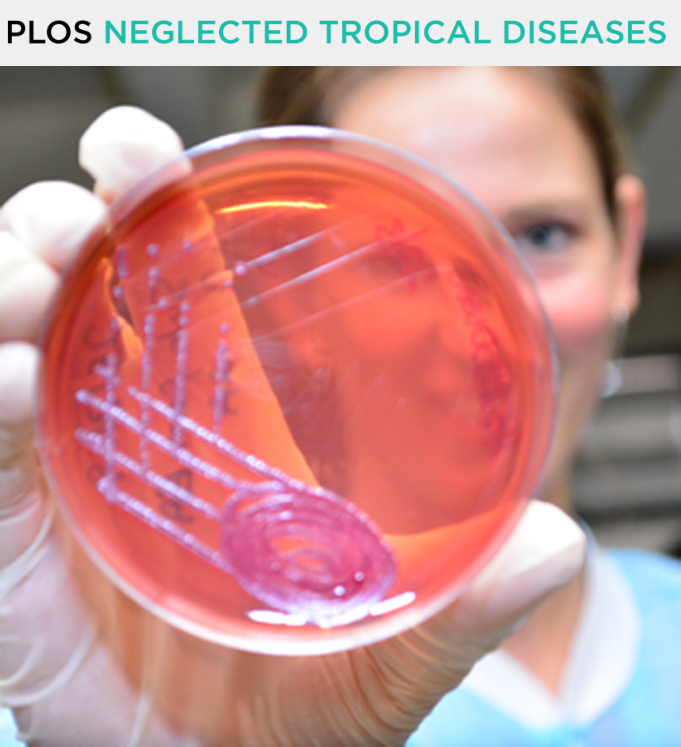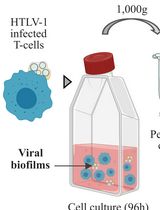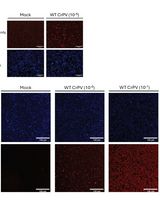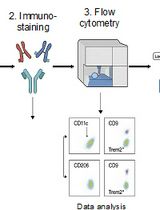- EN - English
- CN - 中文
Production, quantification, and infection of Amazonian Phlebovirus (Bunyaviridae)
亚马孙流域白蛉病毒属(布尼亚病毒科)的产生、定量和感染
(*contributed equally to this work) 发布: 2021年07月05日第11卷第13期 DOI: 10.21769/BioProtoc.4072 浏览次数: 3649
评审: Woojong LeeAlexandros AlexandratosAnonymous reviewer(s)
Abstract
Phlebotomine vectors, sand flies of the order Diptera, are known to transmit Leishmania parasites as well as RNA viruses (arboviruses) to humans. The arbovirus, Icoaraci Phlebovirus (BeAN 24262 - ICOV), used in this study was isolated from Nectomys rodents, a mammalian species that is the same natural sylvatic reservoir of Leishmania (Leishmania) amazonensis. This Leishmania species is distributed in primary and secondary forests in Brazil and other countries in America and causes localized and diffuse anergic skin lesions. In our recent studies, we observed an aggravation of the protozoan infection by ICOV through the modulation of cytokine expression, such as IL-10 and IFN-β, enhancing the parasite load and possibly the pathogenesis. Efficient viral production and quantitation had to be developed and standardized to ensure that immuno-molecular assays provide consistent and reproducible viral infection results. The standardization of these procedures becomes a particularly useful tool in research, with several applications in understanding the interaction between the host cell and Phlebovirus, as well as co-infections, allowing the study of intracellular signaling pathways. Here, we detail a protocol that allows the production and quantitation of the Icoaraci Phlebovirus using BHK-21 cells (baby hamster kidney cells) and subsequent infection of peritoneal macrophages from C57BL/6 mice.
Keywords: Phlebovirus (白蛉病毒属)Background
In Brazil, approximately 210 different types of arboviruses have been isolated, of which 196 were found in the Brazilian Amazon (Rosa et al., 1998; Azevedo et al., 2007), one of the largest reserves of arboviruses in the world. The Bunyaviridae family is composed of more than 350 viruses divided into five genera, among which Orthobunyavirus, Phlebovirus, Nairovirus, and Hantavirus contain species pathogenic to humans and animals, while the genus Tospovirus is pathogenic only to plants (Walter and Barr, 2011; Ly and Ikegami, 2016).
In most human cases, Phlebovirus cause a wide spectrum of symptoms from mild febrile illness to hemorrhagic fever and death (Bird et al., 2009; Ikegami and Makino, 2011; Brisbarre et al., 2015). A specific member of Phlebovirus, the Rift Valley Fever virus, is potentially dangerous to pregnant domesticated animals such as cattle, goat, and sheep, with infection resulting in fetal malformation and abortion (Swanepoel and Coetzer, 2004). In this work, we used the Icoaraci Phlebovirus (BeAN 24262), which is prevalent in small forest animals (Causey and Shope, 1965). All Phlebovirus are morphologically similar: 80-120 nm in diameter, icosahedral symmetry, and enveloped with two surface glycoproteins (Gn and Gc) (Freiberg et al., 2008). The single-stranded RNA (ssRNA) is segmented and packaged within ribonucleoprotein particles (RNPs) by protein N and associated with an RNA-dependent RNA polymerase (RdRp). The small (S) segment uses the ambisense coding strategy, coding for a nucleocapsid protein (N) and non-structural protein (NSs) (Simons et al., 1990; Giorgi et al., 1991).
Studies in animal models suggest a protective effect of type I interferon (IFN) in infection caused by Phlebovirus (Mendenhall et al., 2009). Most viruses have developed the ability to express proteins capable of preventing the immune response (Habjan et al., 2009). This antagonistic activity has been observed for several non-structural viral proteins (Van Knippenberg et al., 2010) by mechanisms that explore different targets in IFN signaling pathways. Although Phlebovirus exhibit different levels of pathogenicity, the NSs protein is considered an important virulence factor for all members of the genus, as well as other members of the Bunyaviridae family (Habjan et al., 2009; Ikegami et al., 2009).
Several studies have shown the importance of the relationship between viruses and Leishmania parasites in the establishment of reciprocal adaptive advantages that promote survival and persistent infection (Ives et al., 2011; Hartley et al., 2012; Vivarini et al., 2015; Eren et al., 2016; Rath et al., 2018). Our group previously demonstrated that the induction of antiviral pathways by L. amazonensis increases macrophage infection (Pereira et al., 2010; Vivarini et al., 2015). Different Leishmania species associated with host immunological factors determine distinct clinical manifestations of leishmaniasis (Alvar et al., 2012). The production of leishmanicidal mediators, such as IL-12, IL-6, and reactive oxygen species (ROS), by innate immune cells contributes to infection control (Dayakar et al., 2019), but Leishmania parasites are able to subvert the signaling pathways that trigger these mechanisms and instead induce pathways favoring the infectious process. Using Icoaraci Phlebovirus as a model, we demonstrated that this virus potentiates infection by L. amazonensis in macrophages. Increased macrophage infection requires toll-like receptor 3 (TLR3) and protein kinase R (PKR) pathways due to the production of type I IFNs induced by the Leishmania and amplified during co-infection with the virus (Rath et al., 2019). Our results highlight the importance of complex and multifactorial analysis of infectious processes, especially in endemic areas where overlap occurs, as observed between L. amazonensis and Icoaraci Phlebovirus.
Given the socioeconomic impact of Phlebovirus infection and the potential co-infection in cutaneous leishmaniasis, the present protocol for the production, quantitation, and infection of Icoaraci Phlebovirus aims to address the molecular mechanisms associated with the interaction between sand fly-transmitted arboviruses and Leishmania parasite infection in vitro and in vivo in the cell host. Subsequent research using this methodology may reveal important aspects related to the host immune response, helping to outline the pathophysiological phenomena and clinical conditions and clarifying scenarios that may indicate how an antiviral response to double-stranded RNA (dsRNA) can mediate immune-inflammatory and immunopathogenic processes in Phlebovirus infection and co-infections.
Materials and Reagents
Cell culture vessels, plates, and tubes
25-cm2 cell culture flask (Corning, catalog number: CLS430639)
100-mm plates (SARSTEDT, catalog number: 82.1472.001)
6-well cell culture plates (Corning, catalog number: 83.3920)
24-well cell culture plates (Corning, catalog number: 83.3922)
15-ml and 50-ml Falcon tubes (BD Falcon)
Cell counting slides with grids
1.5-ml Eppendorf tubes
Eco Nitrile Gloves (SuperMax)
Filter tips, low-retention: 1,000 µl, 200 µl, 20 µl, 10 µl (Axygen, catalog numbers: 31000LRS, 3200LRS, 320LRS, 310LRS, respectively)
5-ml serological pipettes (SARSTEDT, catalog number: 86.1253.001)
10-ml serological pipettes (SARSTEDT, catalog number: 86.1254.001)
0.22-µm cell culture medium filtration unit (Corning, catalog number: CLS430513-12EA)
Cells
BHK-21 cells (baby hamster kidney cells, ATCC: CCL-10)
Cells are maintained in 25-cm2 cell culture flasks with complete DMEM (DMEM – high glucose and supplemented with 10% heat-inactivated FBS: see Recipe 1) at 37°C in a humidified atmosphere containing 5% CO2. After reaching confluence, cells are subcultured to maintain cell viability. For this, remove the medium and rinse the cells with 3 ml warm PBS without calcium and magnesium. Dissociate the cells using 1 ml trypsin-EDTA solution for 1 min. Add 4 ml complete DMEM, transfer to a new 15-ml conical tube, and centrifuge the cells for 5 min at 300 × g. Resuspend the cell pellet in fresh complete medium and split 1:20 in new flasks.
Phlebovirus
The Icoaraci Phlebovirus (BeAN 24262-ICOV) was obtained from Dr. Pedro Vasconcelos (Instituto Evandro Chagas/SVS/MS).
The virus was isolated from the liver, spleen, kidney, and heart of Nectomys squamipes in Belém, Pará, Brazil, and subsequently inoculated intracerebrally in 2-day-old Swiss mice. The samples were lyophilized and stored at -80°C. Before use, reconstitute the samples in 0.5 ml Puck’s medium.
Cell culture reagents
0.25% trypsin-EDTA solution (Sigma-Aldrich, catalog number: T4049), stored at -20°C
Dulbecco’s Modified Eagle’s Medium (DMEM) with 4.5 g/L glucose and L-glutamine (Lonza, catalog number: 12-604Q)
100× penicillin-streptomycin solution (HyClone-GE, catalog number: SV30010)
Puck’s medium (PAN Biotech, catalog number: P04-51100)
Phosphate-buffered saline (PBS) (Lonza, catalog number: 17-516Q)
Fetal bovine serum (FBS) (Thermo Fisher Scientific, GibcoTM, catalog number: 10270106)
UltraPureTM DNase/RNase-free distilled water (Thermo Fisher Scientific, InvitrogenTM, catalog number: 10977-035)
Methylcellulose (Sigma-Aldrich, catalog number: M7027)
100-bp DNA ladder, 500 µg/ml (Promega, catalog number: G201A)
6× gel loading dye (Promega, catalog number: G190A)
Standard agarose for routine gel electrophoresis (UniScience, catalog number: AGR-LE-100)
Ethidium bromide (Sigma-Aldrich, catalog number: E7637)
Tris-base (Promega, catalog number: H5131)
Glacial acetic acid (Sigma-Aldrich, catalog number: A6283)
UltraPureTM 0.5 M EDTA (Ethylenediaminetetraacetic acid, disodium salt dihydrate), pH 8.0 (Thermo Fisher Scientific, catalog number: 15575020)
Crystal violet (Sigma-Aldrich, catalog number: C0775)
Sodium thioglycolate (Sigma-Aldrich, catalog number: T0632), stored at room temperature
Direct-zolTM RNA MiniPrep Plus kit (Zymo Research, catalog number: R2070)
ImProm-IITM Reverse Transcription System (Promega, catalog number: A3800)
Random primers (Promega, catalog number: C1181)
GoTaq® DNA polymerase (Promega, catalog number: M3001)
Complete DMEM (see Recipes)
Semi-solid medium (see Recipes)
Crystal violet solution (see Recipes)
10× TAE Buffer (1 L) (see Recipes)
1× TAE Buffer (1 L) (see Recipes)
1.5% agarose gel (see Recipes)
100-bp DNA ladder (50 µg/ml) (see Recipes)
3% sodium thioglycolate (see Recipes)
Equipment
P1000 (Gilson, catalog number: F123602)
P200 (Gilson, catalog number: F123601)
P20 (Gilson, catalog number: F123600)
P2 (Gilson, catalog number: F144801)
Lab refrigerator set at 4°C (Electrolux, model: IF55)
Lab freezer set at -20°C (Prosdocimo, model: F21)
Lab freezer set at -80°C (Panasonic, model: MDF-U56VC-PA)
Incubator at 37°C with 5% CO2 (Sanyo inCU-Safe, model: MCO-17AC)
Laminar flow hood (Esco Class II BSC- AirStream)
Centrifuge 5418 (Eppendorf) at room temperature; set here at 24°C
Centrifuge (ThermoFisher Scientific, model: D-37520)
NanoDropTM ND-1000 Spectrophotometer (ThermoFisher Scientific)
Balance (BEL Analytical Equipment, model: S622)
Veriti 96-Well thermal cycler (Applied Biosystems PCR instruments, model: 9902)
Mini-gel migration system (Loccus Biotecnology, model: LCH-7X8)
Electrophoresis power supply (GIBCO BRL, Life Technologies, 250) and power cables
U.V. transilluminator (Fisher Scientific, model: 88A)
Procedure
文章信息
版权信息
© 2021 The Authors; exclusive licensee Bio-protocol LLC.
如何引用
Rath, C. T., Vivarini, A. C., Pereira, R. M. and Lopes, U. G. (2021). Production, quantification, and infection of Amazonian Phlebovirus (Bunyaviridae). Bio-protocol 11(13): e4072. DOI: 10.21769/BioProtoc.4072.
分类
微生物学 > 微生物细胞生物学 > 病毒繁殖
细胞生物学 > 细胞分离和培养 > 病毒分离
免疫学 > 免疫细胞分离 > 巨噬细胞
您对这篇实验方法有问题吗?
在此处发布您的问题,我们将邀请本文作者来回答。同时,我们会将您的问题发布到Bio-protocol Exchange,以便寻求社区成员的帮助。
提问指南
+ 问题描述
写下详细的问题描述,包括所有有助于他人回答您问题的信息(例如实验过程、条件和相关图像等)。
Share
Bluesky
X
Copy link












